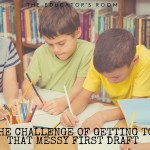My philosophy in teaching, and in life, is to leave things better than you found them. Each person is placed here for a purpose and a reason. As an educator, it is my role to foster the strengths within each student and help them reach their potential. This task, while difficult, is possible through small steps, learning from failures, and having goals. I focus my classroom decisions around this philosophy.
There are many goals set in a classroom during the year. I start with an overall map, set units of instruction that each have specific curriculum goals to be taught and met. I also have life skill goals that are interwoven through classroom management, cooperative learning, inquiry based learning and habits of mind. Then there are individual student goals. All students come to my classroom with different experiences and therefore each have their own individual goals. Being clear on the expectations and communicating our goals clearly helps us see the path.
Formative assessment, the practice of using formal and informal assessment during learning to gather information used to modify activities to improve student success, is a great tool for helping me and my students know where we are in tracking our goals. There are many practices that support formative assessment. In this series I will give some examples and ideas of these practices including setting clear objectives, providing success criteria, using peer editing, and higher level questioning which all support formative assessment. This week we will discuss setting clear objectives.
There are always phases that pass through education. A few years ago “clip charts” were all the buzz. During the past year it seems “posting objectives” has become the rage. Search either one on Pinterest and you will find boards with links. I always takes pieces of these phases and match them to my personal philosophy to refine and keep what makes sense in my classroom. Posting objectives makes sense, if you are doing it in a purposeful way.
“We learn more by looking for the answer to a question and not finding it than we do from learning the answer itself,” Lloyd Alexander. What are your students learning today? Where are you headed? Teachers and students need to know the answers to these questions in order to move their learning forward.
Posting your objectives is an important piece of formative assessments. It goes beyond having them displayed in your classroom though. Communicating your objectives is key. Your objectives should be in language you use with your students and language they understand. This is a way to reinforce vocabulary. In our district we have them posted on whiteboards in the classroom. They are used to introduce a lesson and then referred to throughout the lesson (this is a very important step). Before students begin independent or group work, it is important to restate the objectives again. At the end of the day I have my students copy or paraphrase the daily objectives in their agenda. This allows them to share what they are learning with parents. Communicating what students are learning helps them focus their own learning.
There are other ways to post objectives as well. If you have technology in your classroom they can be posted on the smartboard, interwrite, PowerPoint or whatever means of presentation you use. Younger students can have visual icons or pictures that help them connect to the objectives. If you are providing a lab or worksheet for students, include the objective in the footer for students to reference. Using objectives gives your lessons, your students and yourself a common focus on where you are going.
The connection between objectives and formative assessment is simple: if you know where you are going, you can see if you have made it there. Objectives help students make connections among lessons. They should be able to use the objectives to see how their learning is progressing and where it is going. This allows you to observe their learning and know if the lesson is going as you desire. Exit tickets, teacher observations, clicker system questions, or anything else you use in formative assessment should tie back to your objective. Asking students one or two questions or providing them with a prompt on the objective should show you where their learning is. Setting clear objectives allows your formative assessment to be successful.
Each teacher, classroom, district, state has objectives for their students. The learning that will occur throughout the year is tied to learning from previous years and learning that will occur in the future. Communicating your objectives clearly with students and families allows you to see the path each student is taking in their learning. It allows you to use formative assessment as a tool to adjust, re-teach, and extend learning for all children.






Leave a comment